Review: SymPaper
Score:
85%
Read It Later is a service which allows you to queue up interesting links to read later. To streamline loading times, Read It Later delivers your saved page in a text only form, for reading either on their website, or offline with a mobile application. Therein lays the rub for Symbian users, there has been no mobile application for Read It Later. This is where Talvinder Bansal (of SymFTP fame) comes to the rescue, with his SymPaper application, a Read It Later client written in Qt. Read on find out more.
Version Reviewed: 2.1
Buy Link | Download / Information Link
In the social media age, we have links coming at us left, right and centre, and there isn't enough time in a day to get them all processed and read. That's why having some sort of system to defer your reading material is an essential tool, Read It Later is one such tool. It started out as a Firefox plugin, but is now available for almost every platform. Another problem solved by Read It Later is cutting down both distractions and loading times by presenting an offline text only copy of saved pages. In the interests of balance, I should mention that Instapaper provides much the same service, but it lacks a Symbian application. Oh, and if users of Google Reader want to know how to add Read It later to their 'Send To' menu, click here.
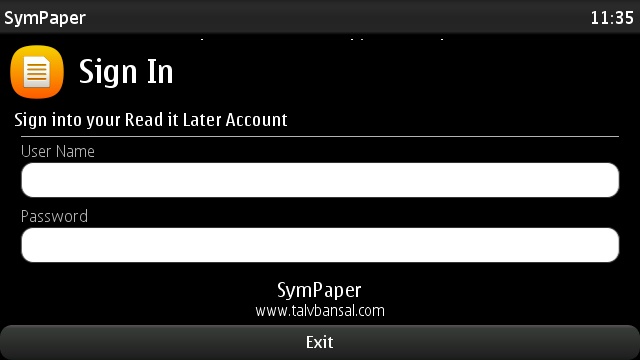
SymPaper login screen
Befitting a Read It Later client, SymPaper is a simple application. After logging into the application for the first time, SymPaper synchronises with your account. By default you are shown the “All” view, by tapping the centre-bottom icon you can switch between viewing just your unread or read links. The other two buttons on the toolbar are Settings (right) and Add an article to your account (left). The main feature users will be interested in on the settings menu is the manual synchronisation option. The developer of SymPaper told me that he made synchronisation have manual control because the application was designed for people out and about on limited bandwidth, and so he wanted to give them full control over their phone's connectivity.
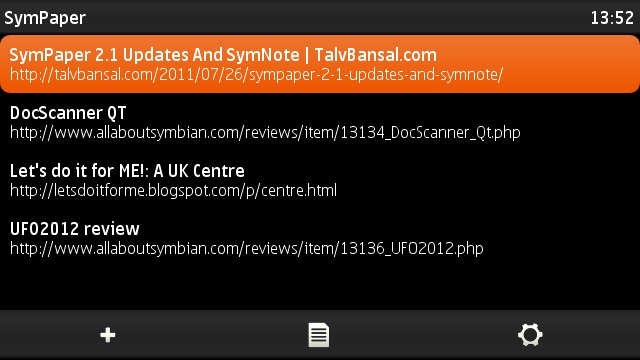
SymPaper's 'All' view
The 'Add Article' screen is straightforward, with fields for the article title and URL. Each field has a complementary paste button, allowing you to easily copy data from other applications via the clipboard. Of course, pasting both lines does mean switching to SymPaper twice, and so pasting in the URL and then typing in a short title of your own might be the easier option. This form filling approach does feel rather pedestrian, compared to Android, where applications are all integrated via the share menu. However, this is a shortcoming of Symbian, not SymPaper!
Most of the time, I expect users will be adding links via their desktop browser, for 'away from keyboard' perusal on their mobile device. However, in addition to pasting URLs from Web or Opera, the premier Twitter client, Gravity, supports sending links to Read It Later. This means that users can add interesting links to Read It Later, via Gravity, and then synchronise SymPaper for offline reading!
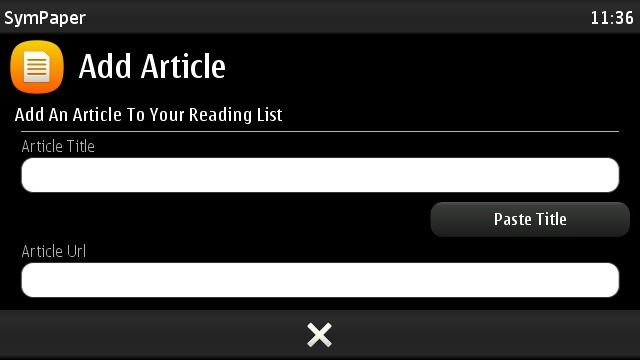
SymPaper's 'Add Article' form
Viewing an article is a minimum fuss affair. Articles are presented in plain text, but simple formatting like headings, lists, etc., are preserved. There are two font sizes, which is useful if your eyesight is struggling, and there is smooth kinetic scrolling. Images are not displayed, which will be a problem for some articles, but that is what you get with Read It Later. Also, SymPaper uses white text on a black background (with orange headings), which is a smart move for battery life, what with the OLED screens on Symbian^3 devices. After you've read an article, you have to manually mark it as read; that status is then synchronised back to Read It Later. This manual updating is in line with SymPaper's modus operandi of giving users complete control of when the application goes online, for working in limited connectivity environments.
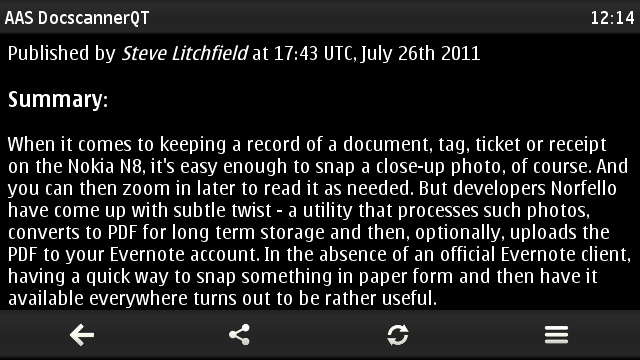
Viewing an article in SymPaper
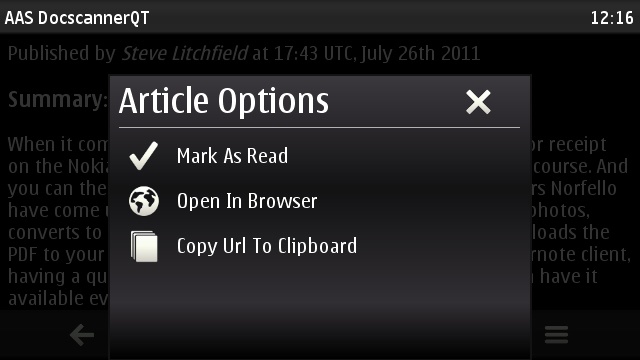
The actions menu for articles in SymPaper
Finally, SymPaper has good sharing support. Sharing via SMS or Email gives you a message with the only URL in the body text. I'd have liked to have seen the article title appear in the email subject (again, I believe this is a limitation in Symbian). Fortunately, sharing via Twitter and Facebook is supported too. To connect to each service for the first time, an embedded login page is presented to achieve OAuth authentication. Sharing via Twitter gives you the article title, with the URL automatically shorted via Twitter's t.co domain. When sharing with Facebook, you have a traditional 'shared item' posted to your wall.
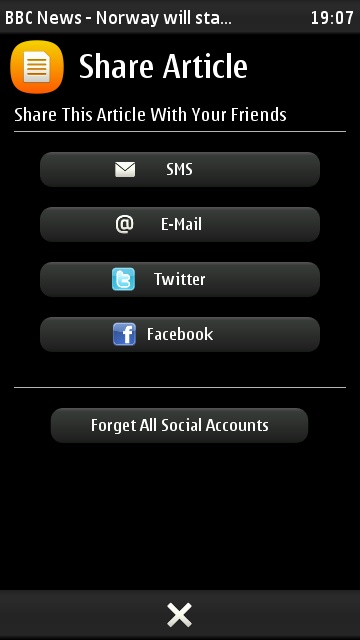
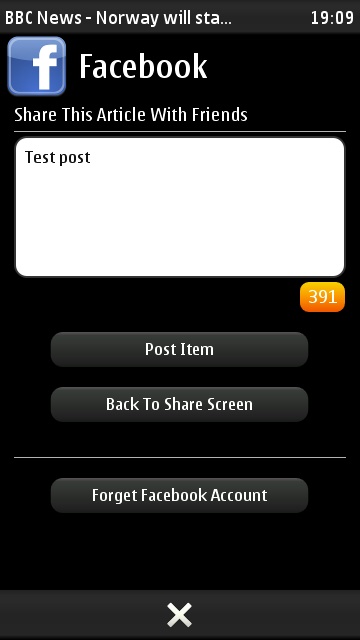
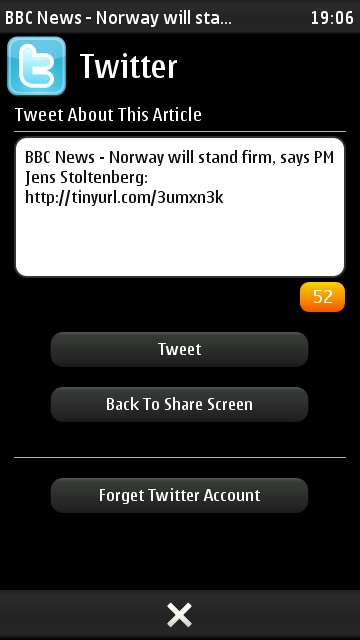
Sharing items from SymPaper
Overall, if you're a regular user of Read It Later, and need read pages offline, SymPaper is the automatic (and only) choice. The user interface is a great example of how Qt applications should look and behave, and you can see hints in the UI of the forthcoming changes in Symbian Belle. My only issue with SymPaper is the price. The official “Read It Later Pro” application for Android costs £1.83, while SymPaper is £3.00, which feels pricey. Having said that, after reviewing SymPaper, I bought my own copy, happy in the knowledge that I was getting a useful application and supporting a Symbian developer.
You can download the SymPaper Trial edition or buy the full version, via the Ovi Store.
Highly recommended.
David Gilson for All About Symbian, 2nd August 2011.
Reviewed by David Gilson at
